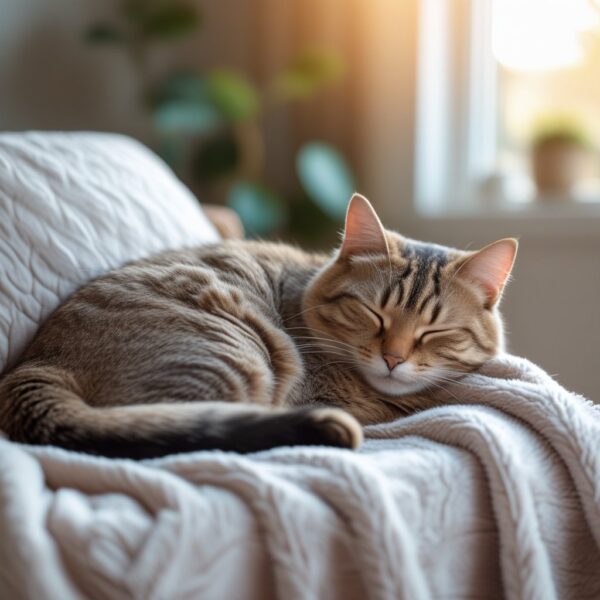
Evolution, Science, and Survival
Cats display a fascinating preference when it comes to their sleeping positions, with research revealing a clear pattern in their resting habits. Two-thirds of domestic cats prefer to sleep on their left side, positioning their left visual field for optimal awareness of their surroundings. This behavior stems from deep-seated evolutionary and neurological factors that have shaped feline survival strategies over thousands of years.
The left-side sleeping preference connects to brain lateralization patterns and serves multiple survival functions. Cats maintain heightened awareness through their left visual field while resting, allowing them to detect potential threats or opportunities more effectively. This positioning also relates to how their brains process information during different sleep phases.
Understanding why cats choose this particular sleeping position reveals insights into their natural instincts and behavioral adaptations. The preference involves complex interactions between evolutionary survival mechanisms, brain function, and environmental factors that influence how cats navigate their daily rest cycles.
Key Takeaways
- Most domestic cats instinctively prefer sleeping on their left side to maintain optimal visual awareness of their environment
- This sleeping position stems from evolutionary survival strategies and brain lateralization patterns that help cats process information more effectively
- Environmental factors and individual behavioral traits can influence a cat’s specific sleeping preferences and positions
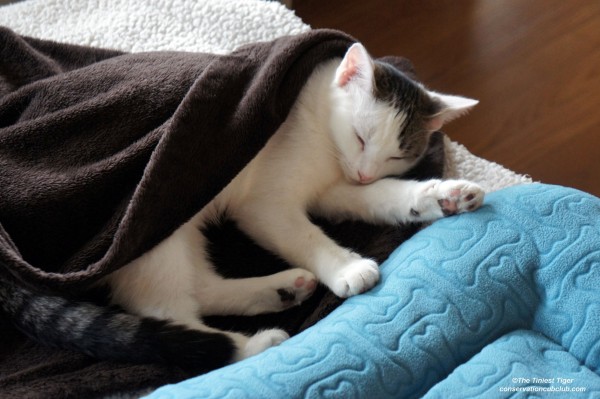
Understanding the Sleeping Habits of Cats
Cats spend 12-16 hours per day sleeping, with their sleep patterns shaped by their evolutionary history as both hunters and hunted animals. Their sleeping behaviors differ significantly from their wild relatives due to domestication.
Typical Sleep Duration and Patterns
Domestic cats sleep an average of 13-16 hours daily, making them one of the longest-sleeping mammals. This extended sleep duration serves multiple biological functions.
Cats experience light sleep for approximately 75% of their rest time. During these periods, they remain alert to environmental sounds and can wake instantly.
Deep sleep occurs in shorter bursts lasting 5-10 minutes. This REM sleep phase allows for physical recovery and memory consolidation.
Their sleep cycle follows a polyphasic pattern with multiple short naps throughout the day. Most cats are crepuscular, meaning they are most active during dawn and dusk hours.
| Sleep Phase | Duration | Characteristics |
|---|---|---|
| Light Sleep | 10-30 minutes | Easily awakened, ears may twitch |
| Deep Sleep | 5-10 minutes | Complete muscle relaxation, dreaming occurs |
Cats as Both Predators and Prey
The dual nature of cats as hunters and potential prey animals significantly influences their sleeping habits. This evolutionary background explains many of their rest behaviors.
As predators, cats conserve energy through extended sleep periods. Hunting requires intense bursts of energy, making rest essential for successful prey capture.
Their prey instincts also affect sleep positioning. Cats often sleep in locations that provide quick escape routes or elevated vantage points.
Defensive sleeping behaviors include:
- Choosing hidden or protected locations
- Sleeping with one ear positioned to detect threats
- Maintaining muscle tension for rapid awakening
Wild cats must balance rest with vigilance. This creates a sleep pattern that prioritizes safety over comfort.
Domestic Cats Versus Wild Relatives
Domestication has significantly altered feline sleep patterns compared to their wild counterparts. House cats enjoy extended sleep periods due to reduced survival pressures.
Wild cats typically sleep 8-10 hours daily, spending more time hunting and defending territory. Domestic cats can afford longer rest periods because humans provide food and shelter.
Key differences include:
- Domestic cats sleep 3-6 hours more per day
- House cats experience less interrupted sleep
- Wild cats maintain higher alertness levels during rest
Indoor cats often develop more flexible sleep schedules. They may adjust their patterns to match their human companions’ routines.
The security of domestic environments allows cats to achieve deeper sleep states more frequently. This explains why house cats often appear more relaxed during rest periods than their wild relatives.
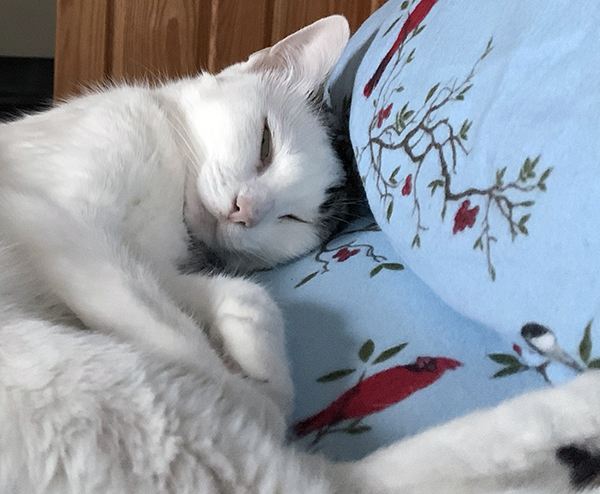
The Science Behind Left-Side Sleeping in Cats
Research into feline sleeping patterns reveals that approximately two-thirds of domestic cats demonstrate a preference for sleeping on their left side. This lateralized behavior has been documented through controlled studies examining sleeping position choices in household cats.
Recent Research and Video Analysis
Scientists have conducted systematic observations of domestic cats to understand their sleeping position preferences. These studies utilized video recording techniques to monitor cats during their natural sleep cycles without human interference.
The research methodology involved tracking cats in their home environments over extended periods. Researchers recorded multiple sleep sessions to establish consistent patterns rather than isolated incidents.
Video analysis allowed scientists to document the precise positioning of cats during different sleep phases. This approach provided objective data about which side cats naturally chose when settling down to rest.
The studies focused specifically on lateral sleeping positions, excluding other common cat sleeping postures like curled positions or belly-up sleeping.
Prevalence of Left-Side Preference
Statistical analysis of sleeping position data shows that approximately 67% of domestic cats prefer their left side for sleeping. This represents a significant majority rather than random positioning.
The left-side preference appears consistent across different cat breeds and ages. Individual cats tend to maintain this preference over time rather than switching sides randomly.
Research indicates that this lateral bias for sleeping position is measurable but less pronounced than other directional preferences cats display. The preference exists but varies in strength between individual animals.
Some cats show flexible sleeping habits, but the overall population data clearly demonstrates the left-side trend across domestic cat populations.
Key Findings from Studies
Sleep research in cats has identified distinct sleeping stages where positional preferences become apparent. Cats maintain their left-side preference during both light sleep phases and deeper sleep periods.
The lateralization extends beyond just sleeping position to other spontaneous behaviors in domestic cats. However, sleeping side preference represents one of the most consistent directional behaviors observed.
Studies measuring brain activity during sleep found that positional preferences correlate with specific neural patterns. Left-side sleeping may relate to how cats process visual information during rest periods.
Researchers noted that the sleeping position preference appears to be an inherent behavioral trait rather than learned behavior from environmental factors.
Evolutionary Advantages: A Survival Strategy
The preference for left-side sleeping in cats represents an evolutionary survival strategy that maximizes protection while maintaining alertness. This positioning reduces vulnerability during rest periods and optimizes the body’s defensive capabilities.
Vulnerability During Sleep
Sleep creates a natural state of reduced awareness that makes cats vulnerable to predators and threats. During extended rest periods, cats must balance the need for energy conservation with survival requirements.
The left-side sleeping position minimizes exposure of vital body regions. By positioning themselves on their left side, cats keep their dominant right paw free for immediate defensive action.
This positioning also allows cats to maintain partial sensory awareness. Their ears remain elevated and mobile, enabling them to detect approaching sounds while resting.
Key vulnerability factors during sleep:
- Reduced reaction time to threats
- Decreased sensory perception
- Limited mobility during deep sleep phases
- Exposure to environmental dangers
Protecting Vital Organs
The left-side sleeping position provides enhanced protection for critical internal organs. The heart, positioned slightly left of center, receives additional cushioning from the ribcage when lying on the left side.
This positioning reduces pressure on the liver, which sits on the right side of the body. The liver’s protection becomes crucial for cats’ metabolic functions and toxin processing.
The stomach and spleen also benefit from left-side positioning. This arrangement promotes better blood flow and reduces compression of major blood vessels.
Organ protection benefits:
- Heart receives ribcage shielding
- Liver experiences reduced pressure
- Improved circulation to digestive organs
- Enhanced lymphatic drainage
Optimal Readiness for Threat Response
Left-side sleeping enables cats to spring into action more efficiently when threats emerge. The position allows for rapid transition from rest to active defense or escape.
Most cats are naturally right-pawed, making the left-side position advantageous for keeping their dominant paw accessible. This positioning enables immediate striking or grasping motions without requiring body repositioning.
The head and neck alignment during left-side sleep maintains optimal blood flow to the brain. This circulation pattern supports faster cognitive processing when awakening suddenly.
Response readiness factors:
- Dominant paw remains free for action
- Faster transition to standing position
- Maintained neck mobility for head turning
- Quick access to primary escape routes
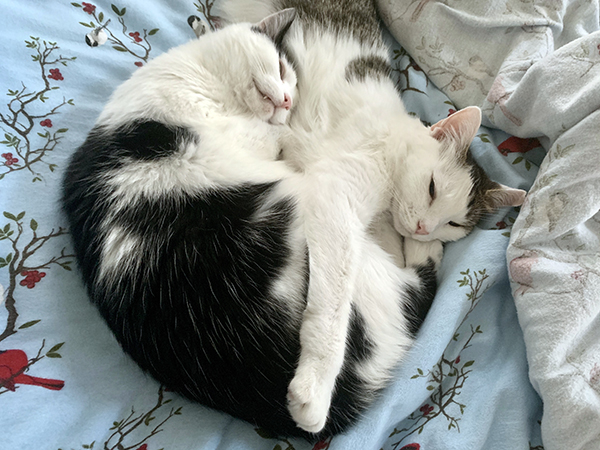
Brain Lateralization and the Left Visual Field
Cats’ preference for sleeping on their left side connects directly to how their brain processes visual information and responds to threats. The left visual field projects to the right hemisphere, which specializes in detecting danger and processing emotional responses.
How Sensory Information Is Processed
The feline brain follows a crossed pattern for visual information processing. The left visual field connects to the right hemisphere, while the right visual field connects to the left hemisphere.
This arrangement means cats sleeping on their left side position their left eye upward. Upon awakening, this eye immediately scans the left visual field. The visual data flows directly to the right hemisphere for processing.
Key Processing Pathways:
- Left visual field ? Right hemisphere
- Right visual field ? Left hemisphere
- Crossed neural connections ensure rapid information transfer
The brain’s lateralized structure allows for specialized processing of different types of visual information. Each hemisphere develops distinct capabilities for handling specific environmental cues.
This processing system operates continuously, even during light sleep phases. The brain maintains readiness to interpret visual signals from the dominant eye position.
Role of the Right Hemisphere in Threat Detection
The right hemisphere specializes in processing threats and emotional responses in cats. This brain region handles predator detection, stress responses, and survival-related decisions.
Research shows the right hemisphere processes information from widespread areas of the visual field more effectively. It integrates multiple sensory inputs to assess potential dangers quickly.
Right Hemisphere Functions:
- Threat assessment and predator detection
- Emotional processing and stress responses
- Spatial awareness and environmental scanning
- Fight-or-flight response coordination
The right hemisphere’s connection to the left visual field creates an advantage for cats sleeping on their left side. This positioning allows immediate threat assessment through the preferred neural pathway.
Cats with strong right hemisphere activity show heightened awareness of environmental changes. This brain lateralization represents an evolutionary survival strategy that enhances protective responses.
Visual Field Exposure and Rapid Reactions
Sleeping on the left side maximizes the left visual field’s exposure to the environment. This positioning enables faster visual processing through the right hemisphere’s threat detection systems.
The left visual field provides optimal coverage of the surrounding area during rest. Cats can monitor potential threats without moving their head or body position significantly.
Reaction Time Benefits:
- Immediate left visual field scanning
- Direct right hemisphere activation
- Reduced processing delays
- Enhanced threat recognition speed
This arrangement functions as an evolutionary survival strategy that balances rest with vigilance. The left-side sleeping position maintains protective awareness while allowing necessary sleep.
The visual field advantage becomes particularly important in environments with potential predators. Cats retain the ability to detect movement and assess threats through their optimized brain lateralization system.
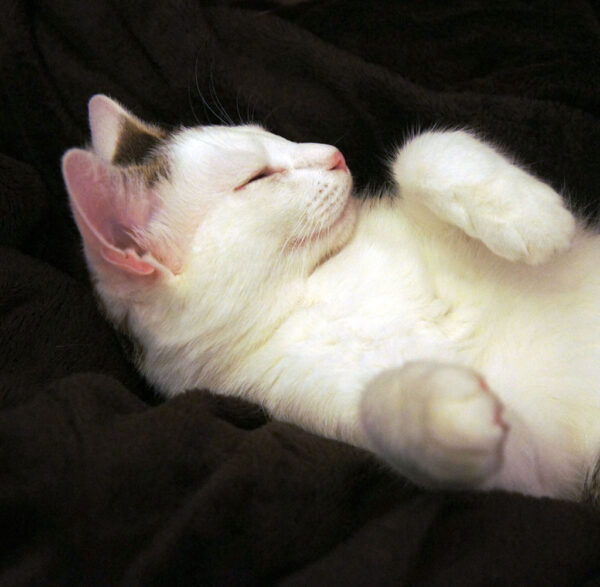
Behavioral and Environmental Influences
A cat’s preference for left-side sleeping stems from complex behavioral patterns and environmental factors that shape their sleep choices. The sleeping environment, stress levels, and species-specific behaviors all play crucial roles in determining how cats position themselves during rest.
Influence of Sleeping Locations
Cats actively select sleeping locations based on environmental factors that support their natural behavioral needs. Distinct sleeping areas separate from feeding and elimination zones help cats maintain their preferred sleep positions.
Environmental enrichment through appropriate sleeping spaces influences how cats position themselves. Cats often indicate their preference for elevated surfaces by consistently choosing these locations for rest.
The physical characteristics of sleeping areas affect positioning choices. Soft surfaces that conform to body shape encourage side sleeping, while harder surfaces may promote different positions.
Temperature regulation plays a significant role in sleep positioning. Cats seek areas with optimal thermal comfort, which can influence whether they adopt left-side sleeping positions.
The presence of visual barriers and enclosed spaces supports cats’ security needs during sleep. These environmental features encourage relaxation and specific sleep postures.
Stress Reduction and Security
Stress-related factors significantly impact how domestic cats position themselves during sleep. Left-side sleeping may serve as a stress-reduction mechanism that promotes deeper rest cycles.
Cats experiencing environmental stressors often alter their sleep positions and locations. Secure environments that minimize disturbances support consistent sleep positioning patterns.
The threat processing capabilities of cats influence their sleep positioning choices. Left-side sleeping may provide optimal sensory awareness while maintaining relaxation.
Environmental stability reduces stress-related sleep disruptions. Cats in consistent, predictable environments demonstrate more regular sleep positioning patterns.
Stress-related illness can develop when cats lack appropriate sleeping environments. Proper environmental management supports natural sleep behaviors and positioning preferences.
Comparison to Other Animal Species
Domestic cats share lateralized sleeping behaviors with other mammalian species, though specific positioning preferences vary between species.
Many mammals demonstrate side-sleeping preferences, but the directional bias toward left-side positioning appears more pronounced in cats. This behavioral pattern reflects species-specific neurological and physiological adaptations.
Brain lateralization influences sleep positioning across different animal species. Cats exhibit distinct patterns compared to dogs and other domestic animals in their sleep positioning choices.
Environmental factors affect sleep positioning differently across species. While cats prefer elevated, enclosed spaces, other animals may choose different environmental conditions that influence their sleep postures.
The evolutionary adaptations of cats as both predators and prey animals create unique sleep positioning requirements not found in other domestic species.
Frequently Asked Questions
Cat guardians often wonder about the significance of their cat’s sleeping behaviors and what these patterns reveal about their feline’s well-being. Research shows that two-thirds of cats prefer sleeping on their left side, which relates to brain lateralization and comfort preferences.
What are common sleeping positions for cats and their meanings?
Cats display several distinct sleeping positions that indicate their comfort level and state of alertness. The most common position is lying on their side, with research showing a preference for the left side among domestic cats.
When cats sleep curled up in a ball, they are conserving body heat and protecting vital organs. This position suggests the cat feels secure but maintains some defensive awareness.
Cats sleeping on their backs with bellies exposed demonstrate complete trust and relaxation. This vulnerable position indicates the cat feels entirely safe in their environment.
The loaf position, where cats tuck their paws under their body, allows for quick awakening and movement. This semi-alert posture shows the cat is resting but ready to respond to stimuli.
How do feline sleeping habits reflect their health and comfort?
Healthy cats typically sleep 12-16 hours per day in various cycles of light and deep sleep. Changes in sleeping duration or patterns can indicate health issues that require veterinary attention.
Cats entering REM sleep demonstrate normal brain function and psychological well-being. During this phase, cats may twitch or move their paws, indicating active dreaming.
A cat’s choice of sleeping location reflects their comfort with their environment. Cats who sleep in open areas show confidence, while those hiding may feel stressed or unwell.
Since cats naturally hide signs of weakness, guardians should monitor for subtle changes in sleeping behavior. Increased hiding during sleep or dramatic changes in sleep patterns warrant veterinary evaluation.
Is there a scientific reason behind cats’ preference for a particular side while sleeping?
Research indicates that approximately two-thirds of cats prefer sleeping on their left side. This preference relates to brain lateralization, where the right brain hemisphere controls left-side body movement.
The left-side sleeping position gives cats better access to their left visual field during rest. This positioning may provide evolutionary advantages for detecting threats or opportunities.
Brain lateralization in cats influences their sleeping preferences similar to handedness in humans. Right-brain dominance in cats makes left-side sleeping more comfortable and natural.
This sleeping preference appears consistent across different cat populations. The scientific basis suggests an inherent neurological reason rather than learned behavior.
Do cats choose their sleeping spots based on safety and security considerations?
Cats select sleeping locations based on their assessment of safety and environmental threats. They prefer elevated positions that provide good vantage points and escape routes.
Proximity to their human companions during sleep indicates trust and security. Cats who sleep close to their owners feel protected and comfortable in their presence.
Multiple cats in households may choose different sleeping areas to avoid conflict. This behavior reflects their natural territorial instincts and need for personal space.
Environmental factors like noise levels, temperature, and foot traffic influence sleeping spot selection. Cats gravitate toward quiet, warm areas with minimal disturbance.
What can a Cat Guardian infer from a cat’s sleeping patterns?
Normal sleeping patterns indicate a healthy, well-adjusted cat who feels secure in their environment. Consistent sleep schedules suggest good physical and mental health.
Changes in sleeping duration, location, or frequency can signal health problems or stress. Cats who suddenly sleep more or less than usual may require veterinary examination.
The timing of sleep cycles reflects a cat’s adaptation to household routines. Cats often adjust their sleep patterns to match their guardian’s schedule over time.
Sleeping positions and locations provide insight into a cat’s emotional state. Confident cats sleep openly, while anxious cats may hide or choose isolated spots.
How does the way cats sleep indicate their trust and relationship with their human companions?
Cats who sleep near their humans demonstrate high levels of trust and attachment. This behavior indicates they view their human as a source of safety and comfort.
Sleeping in vulnerable positions around humans shows complete confidence in their safety. Cats who sleep on their backs or stretch out fully feel entirely secure.
The distance a cat maintains while sleeping reflects their comfort level with human presence. Gradual movement closer to sleeping humans indicates growing trust over time.
Cats who seek out their human’s bed or favorite chair for sleeping show strong social bonds. This behavior demonstrates their desire for closeness and connection with their human family.
- Lateralized sleeping positions in domestic cats Isparta, Sevim et al.Current Biology, Volume 35, Issue 12, R597 – R598